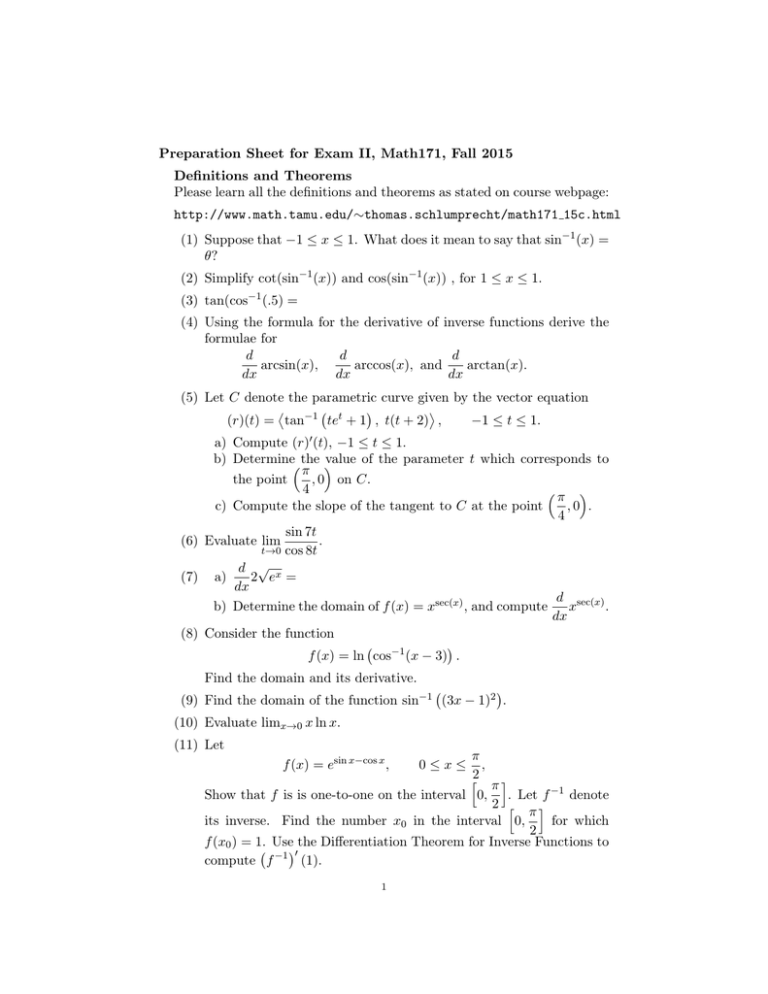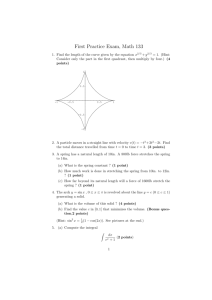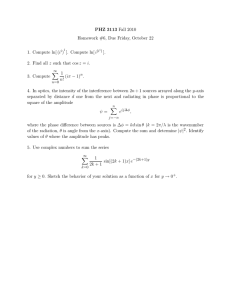Preparation Sheet for Exam II, Math171, Fall 2015 Definitions and Theorems
advertisement

Preparation Sheet for Exam II, Math171, Fall 2015 Definitions and Theorems Please learn all the definitions and theorems as stated on course webpage: http://www.math.tamu.edu/∼thomas.schlumprecht/math171 15c.html (1) Suppose that −1 ≤ x ≤ 1. What does it mean to say that sin−1 (x) = θ? (2) Simplify cot(sin−1 (x)) and cos(sin−1 (x)) , for 1 ≤ x ≤ 1. (3) tan(cos−1 (.5) = (4) Using the formula for the derivative of inverse functions derive the formulae for d d d arcsin(x), arccos(x), and arctan(x). dx dx dx (5) Let C denote the parametric curve given by the vector equation (r)(t) = tan−1 tet + 1 , t(t + 2) , −1 ≤ t ≤ 1. a) Compute (r)0 (t), −1 ≤ t ≤ 1. b) Determinethe value of the parameter t which corresponds to π the point , 0 on C. 4 π c) Compute the slope of the tangent to C at the point ,0 . 4 sin 7t (6) Evaluate lim . t→0 cos 8t d √ x (7) a) 2 e = dx d sec(x) b) Determine the domain of f (x) = xsec(x) , and compute x . dx (8) Consider the function f (x) = ln cos−1 (x − 3) . Find the domain and its derivative. (9) Find the domain of the function sin−1 (3x − 1)2 . (10) Evaluate limx→0 x ln x. (11) Let π , h2 π i Show that f is is one-to-one on the interval 0, . Let f −1 denote 2 h πi its inverse. Find the number x0 in the interval 0, for which 2 f (x0 ) = 1. Use the Differentiation Theorem for Inverse Functions to 0 compute f −1 (1). f (x) = esin x−cos x , 1 0≤x≤ 2 (12) Evaluate limt→1− e1/(t−1) . (13) Find the inverse of f (x) = x−2 . x+2 4 (14) Compute the second derivative of ex . (15) Compute lim x→0+ 1 − cos2 x 1 ln x . Show all your steps clearly. (16) Consider the function x3 − 2 |2x − 1|, −∞ < x < ∞. 3 Determine all the critical numbers of f . Determine the interval(s) in which f is increasing. Determine al local extrema. f (x) = (17) Show for all x, y that | cos(x) − cos(y)| ≤ |x − y|. (18) Assume f is differentiable on (a, b) and there are three roots of the equation f (x) = 0. Show that there are at least two points x for which f 0 (x) = 0. (19) Assume f is continuous on [a, b] and twice differentiable on (a, b) and there are three roots of the equation f (x) = 0. Show that there is at least one point x for which f 00 (x) = 0. (20) Assume that f (x) is continuous on [a, b] and twice differentiable on (a, b). Show that if f (a) = f (b) and if f (x) is concave up, then f (x) has exactly one local minimum which is also the absolute minimum of f (x) on [a, b]. (21) Suppose that f is twice continuously differentiable in an open interval I, and that f 00 (x) > 0 for every x in I. Prove that the function G, defined by G(x) := ef (x) , x ∈ I, is concave upwards in I. (22) Evaluate limx→∞ 3−x (23) Find the domain for ln |x|. (24) What is the range of the inverse f −1 , of f , with f (x) = √ x − 1? (25) If g is the inverse of f (x) = x5 + x3 . What is g 0 (2)? (26) For the following functions find (a) Intervals on which the function is increasing/ decreasing (b) Intervals on which the function is concave up/down (c) Local Maxima/Minima (d) Inflection points, 3 (e) find horizontal and vertical asymptotes, if there are any (f) and based on that information sketch the function f (x) = x4 − 6x2 f (x) = x3 − 5x2 + 3x + 6 f (x) = e−(x−2) 2 f (x) = (x2 − 1))|2x − 1| f (x) = x2 + 2x − 3 2 if x < 0 1 − x f (x) = x + 1 if 0 ≤ x < 2 2 x − 6x + 11 if 2 ≤ x ≤ 3 2 1 + 31/x (28) Solve for x: (27) lim x→0− (a) log2 (x + 2) = 3, x (b) 23 = 5, (c) ln(x − 2e) + ln(x + 2e) = 2 + ln 2. (d) ln(ln(x)) = 1, (29) Compute the linear approximation to f (x) = esin x at x = π. 2 (30) Find the √ linear approximation L(x) to the function f (x) = sin (x) at a = π. (31) Suppose x > 0 and let s denote distance between the points (x, 0) dx ds and (0, 1). If x is changing with time and = 2 compute . dt dt (32) Find the inverse of 10x y= x , 10 + 1 x y = 210 ex + 1 y= . 1 − ex √ (33) Approximatively compute 36.1. (34) Compute cos−1 cos(3π) (35) Compute ln3 x x→∞ x x x b) lim , x→∞ x + 1 a) lim 4 (36) Compute cos(2 tan−1 (3)) (Hint cos(2x) = cos2 (x) − sin2 (x) (37) At which point in the closed interval [−1, 1] does the function f (x) = x sin−1 (x) attain its absolute minimum value? 1 (38) Show that f (x) = is one to one on the interval [0, ∞) and 2 + x2 compute its inverse. 2 e x − 1 − x2 (39) lim . x→0 x3 (40) ln x (41) Evaluate lim √ . x→0 x (42) Differentiate f (x) = ln(2x + 4). (43) A can is to be made to contain 1 L of oil. Find the dimensions that will minimize the cost of the material necessary to produce the can. (44) Consider the function f (x) = 12x1/3 − 3x4/3 . Find all local extreme points and classify them as local maxima Find all inflection points (45) An open box has do be made from a rectangular piece of material (dimensions: 2 by 3 feet) by cutting equal squares from each corner and turning up the sides. Find the dimensions of the box with maximal volume. (46) Find the (absolute) maximum value of the function f (x) = x5 − e−x in the interval [−1, 1] . (47) A poster is to have an area of 180 square inches with 1-inch margins at the bottom and sides and a 2-inch margin at the top. What dimensions will give the largest printed area? (48) Find the point on the line y = 2x − 3 that is closest to the point (−1, 3). (49) Find the dimensions of the rectangle of largest area that has its base on the x- axis and its other two vertices above the x-axis lying on the parabola y = 8 − x2 .








